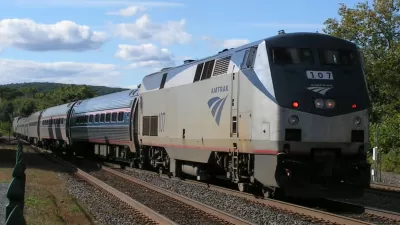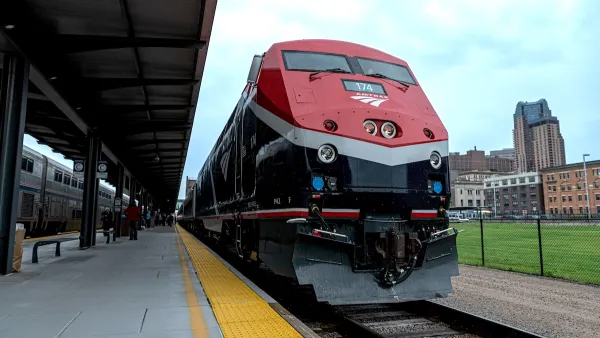States with Amtrak routes less than 750 miles (excludes lines within Northeast Corridor) will need to subsidize the budget shortfalls - the difference between fares and operating costs, or lose the route. States may cut some lines to prop-up others.

Mark Peters writes about the enactment of legislation known as the Passenger Rail Investment and Improvement Act of 2008 (PRIIA) that goes into effect this fall when the 2014 fiscal year beings. The Act requires states to pay the subsidy for shorter routes. Peters takes a closer look at its application in two states - Maine and Pennsylvania.
Maine added service between Portland and Boston a decade ago, recently extending the line farther north to Brunswick. The state supports the service itself, hiring Amtrak to run the trains, while handling marketing and food service on its own, said Patricia Quinn, executive director of the Northern New England Passenger Rail Authority.
She expects the cost shift over the next year will make states become more involved in their train service and look for ways to become more efficient. They also are likely to push Amtrak to become more efficient and could look elsewhere for certain services.
New York's Empire Corridor service, from Penn Station to Albany and Buffalo is one such example. Gov. Andrew Cuomo proposed $44 million to ensure continuation of the service.
RailwayAge's Douglas John Bowen confirms that commitment in his article on Jan. 29.
Allaying fears of cutbacks on Amtrak's Empire Corridor service linking Niagara Falls, Buffalo, Albany, and New York City, New York State says it will maintain existing Amtrak service levels with $44.3 million in state support beginning Oct. 1.
Peters indicates that the funding may prove more of a challenge in Pennsylvania, particularly with lower ridership lines in the western part of the state, including the route from Harrisburg to Pittsburgh. Residents served by that route are organizing to retain the service.
While the state likely will pick up some of the new costs to keep the same service, it will be a challenge to do so for all the routes, said Toby Fauver, deputy secretary for local and area transportation for the Pennsylvania Department of Transportation.
He said, for example, the route between Harrisburg and Pittsburgh is slower than driving and would need considerable updates to become competitive. "It is a struggle for me to want to pay for that service," Mr. Fauver said.
But the state is expected to face pushback from residents of western Pennsylvania. A ridership group held a rally last fall to start drumming up support for the route, which has stops in small towns and cities such as Altoona, Johnstown and Latrobe.
Bowen writes that Vermont and Indiana have yet to determine whether to fund the operating shortfalls for Amtrak routes in their states, and provides contrasting outlooks for rail passengers in these states.
Vermont, which already helps fund the Vermonter and Ethan Allen, is considered likely to continue financing the trains, deemed popular among state residents. By contrast, Indiana seems less likely to aid the Hoosier State, operating between Indianapolis and Chicago; rough estimates by Amtrak of the route's operating cost is between $4 million and $5 million per year.
What is clear will be new attention paid to short-distance Amtrak routes.
"It will force states who haven't paid attention to take a closer look," Ms. Quinn of the Northern New England Passenger Rail Authority said.
[Contributor's note: The link showing "subscriber-only content will be available to non-subscribers for up to seven days after (Jan. 29)"]
FULL STORY: States Weigh Picking Up Train Tab

Planetizen Federal Action Tracker
A weekly monitor of how Trump’s orders and actions are impacting planners and planning in America.

Map: Where Senate Republicans Want to Sell Your Public Lands
For public land advocates, the Senate Republicans’ proposal to sell millions of acres of public land in the West is “the biggest fight of their careers.”

Restaurant Patios Were a Pandemic Win — Why Were They so Hard to Keep?
Social distancing requirements and changes in travel patterns prompted cities to pilot new uses for street and sidewalk space. Then it got complicated.

Platform Pilsner: Vancouver Transit Agency Releases... a Beer?
TransLink will receive a portion of every sale of the four-pack.

Toronto Weighs Cheaper Transit, Parking Hikes for Major Events
Special event rates would take effect during large festivals, sports games and concerts to ‘discourage driving, manage congestion and free up space for transit.”

Berlin to Consider Car-Free Zone Larger Than Manhattan
The area bound by the 22-mile Ringbahn would still allow 12 uses of a private automobile per year per person, and several other exemptions.
Urban Design for Planners 1: Software Tools
This six-course series explores essential urban design concepts using open source software and equips planners with the tools they need to participate fully in the urban design process.
Planning for Universal Design
Learn the tools for implementing Universal Design in planning regulations.
Heyer Gruel & Associates PA
JM Goldson LLC
Custer County Colorado
City of Camden Redevelopment Agency
City of Astoria
Transportation Research & Education Center (TREC) at Portland State University
Camden Redevelopment Agency
City of Claremont
Municipality of Princeton (NJ)





























